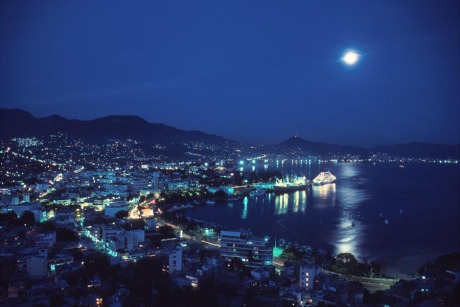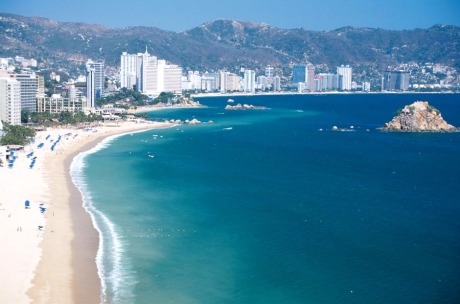by Nancy Seeley Photos by Nadine Markova

Acapulco Bay, night
Acapulco! Some people love it, some people hate it, but everybody’s heard about it. Once the glamour capital of Mexico, its reputation has faded somewhat with the passage of time, but heading there shows you — on a much grander scale — what COULD happen if the current construction boom in Zihuatanejo keeps going at its present breakneck pace.
It’s almost eerie viewing Acapulco Bay from the shoreline, realizing what you’re seeing is Zihuatanejo Bay’s much larger, much glitzier sister. Acapulco Bay stretches for almost seven miles from west to east, far longer than our little crescent, but the shape is similar, and the Sierra Madre del Sur mountain range adds definition to the area’s geographical contours – just as it does here. Also known as La Bahia de Santa Lucia, the bay is three miles long from north to south and between 45 to 180 feet deep.
You can drive to Acapulco in a little more than three hours, or you can take a comfy first class bus that’ll get you there in four to five hours for 133 pesos. Buses leave frequently, but if you don’t want to stop at every little town along the way and spend six hours traveling, make sure you’re not boarding an economico coach. Whichever method you choose, Highway 200 – newly dubbed Ruta 2010 — will take you southeast on a winding, frequently coast-hugging route that eventually deposits you on the city’s main tourism artery, the Costera Miguel Aleman, roughly 150 miles from Zihuatanejo.
With a population approaching two million, Acapulco is about 16 times bigger than Ixtapa-Zihuatanejo, and the tourism options – nearly all of which cluster around the bay itself – offer something for every budget. You can snag a low-cost room in the “old town” area near the zócalo for around 200 pesos a night per couple, where entertainment in the form of outdoor racket that’ll keep you up until the wee hours of the morning is thrown in at no extra charge. Or, you can head way out to the Revolcadero Beach area near the airport at the far eastern end of the bay and plunk down several thousand pesos to experience places like the Acapulco Princess or the Mayan Palace. In between and farther afield, there are half a dozen different “Acapulcos” to explore.

Acapulco Bay
If you’re a sunset lover, you might want to veer off Highway 200 about eight miles shy of Acapulco at Pie de la Cuesta on your southeasterly journey from Zihuatanejo. This laid-back little community boasts some of the best puestas del sol (“sunsets”) to be seen anywhere in Mexico…the kind where you watch an orange ball of flame descend into the sea, hoping to see that splotch of green at the moment it vanishes and not daring to tear your eyes away during the two minutes it takes the sun to drop out of sight once its lower edge “touches” the water.
One of the two places I know to see a similar sight in Acapulco proper is La Angosta (“Narrow”) Beach, located on the west side of Peninsula de las Playas at the western edge of the bay. Popular with locals, it isn’t far from world-famous La Quebrada, where clavadistas (“divers”) daily risk their lives challenging the currents by hurtling 140 feet down off a sheer cliff after praying repeatedly at the much-used Virgin of Guadalupe shrine while viewers wonder whether they’ll chicken out or take the plunge.
The other great sunset place is Sinfonia del Mar, an outdoor amphitheater built specifically for folks to gaze at the dying sun. It’s only a short walk from La Quebrada and is often surrounded by vendors hoping to make a sale while sightseers impatiently wait for Mother Nature’s show to begin. Lots of reasonably priced lodgings around here too, many with that free entertainment bonus (think dueling car radios) mentioned earlier.
Peninsula de las Playas is also home to such oldies but goodies as Hotel Caleta, where a friend and I recently stayed for 500 pesos a night during the off season. Mind you, it took three tries before we found a room we were happy with, but once installed, we were charmed watching the action from our ninth floor balcony. You could see Roqueta Island at the mouth of the bay through binoculars, and you could wander through this grand old property that still exhibits vestiges of splendor from its halcyon days half a century ago.
The zócalo is on the mainland north of the peninsula at the west end of the bay. You can spend hours hanging out at one of many restaurants near the dome-topped Nuestra Señora de la Soledad cathedral and watching everything from jugglers, mimes, and clowns to concerts, beauty contests and political rallies. There are, predictably, scads of tiendas (“shops”) to check out. Although – like here –the majority of goods don’t vary much from place to place, patience and tenacity can often reward you with a treasure you never thought to find.
My favorite way to explore the miles-long Costera Miguel Aleman paralleling the entire length of the bay is on foot. Start right across the street from the zócalo where fishing and sightseeing boats offer their services, continue on past the cruise ship terminal and the Fort of San Diego until you see beach after beach, some of the larger ones being Playa Hornos, Playa Condesa (probably the most popular) and Playa Icacos. Towering tourist hotels, so familiar from pictures of the bay’s profile, often offer online rates significantly discounted from the posted rack rates. Go bungee jumping. Pick your disco for the night.
Wander up into the neighborhoods behind the beaches and see the “real” Acapulco where tourism, though so close, doesn’t play much of a role. If you get tired, scores of taxis and plentiful local buses are never further than a minute away.
Sometimes you just need a north-of-the-border “fix,” and La Costera, as the locals call if, offers you fast food galore – Burger King, McDonald’s, KFC – plus WalMart and (much further east) Costco. Home Depot’s just across the street from Papagayo Park on Avenida Cuauhtemoc, and Office Max is at the corner where you turn to head uphill to Villa Vera, the “in” place of yesteryear where Elizabeth Taylor married third husband MikeTodd in Suite No. 302 and Frank Sinatra held court entertaining behind what is touted as the first swim-up bar in Mexico.
As you proceed east on La Costera, you eventually reach the end of the main bay past the ever-popular Hotel Las Brisas. Still further east you’ll find much smaller Puerto Marques Bay (think Zihuatanejo Bay size-wise.) A recent visit revealed a rather down-at-the-heels pueblo, but one still awash with the kind of views that, under cover of darkness and framed by twinkling lights too numerous to count, transform this rundown locale into a postcard contender.
A second peninsula, which forms the easternmost land mass defining the end of the two bays, offers vantage points from the northwest looking out on both Puerto Marques Bay as well as the mouth of Acapulco Bay. Revolcadero Beach, the site of much new development, is on the peninsula’s southeastern fringe and fronts on the mighty Pacific, with the pizazz of the throbbing city pretty much invisible.
No matter where you choose to stay, though, you can feel the pulse of the area by taking a stroll. For me, it’s been fascinating turning corners wherever the spirit moves me, practicing my Spanish, touring little out-of-the-way hotels, eating tacos at places that don’t open till eight or nine at night – all the while knowing that if I get hopelessly lost (which is pretty much a given), it won’t be long until one of those taxis I mentioned earlier will swing by to rescue me.
